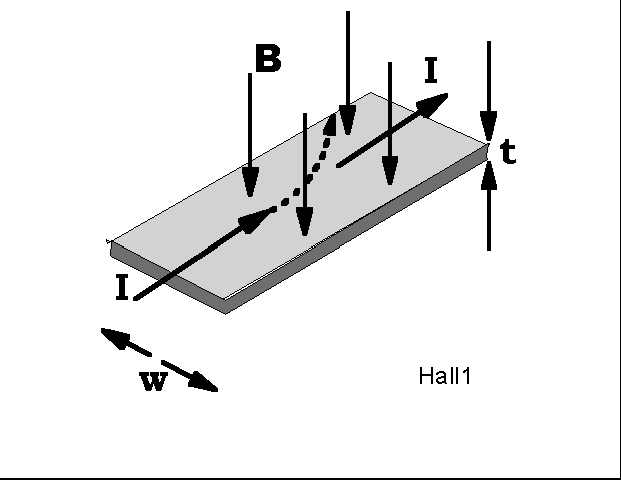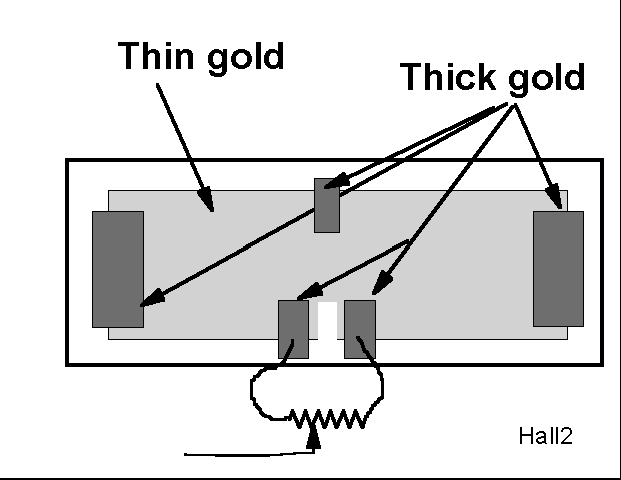Experiment of The Month
The Hall Effect in Gold Films
The MU Physics Department does not claim to have invented these labs. The origin of these labs is currently unknown to us. Our labs do not have written instructions. In keeping with this spirit, the description given here will be brief and general. The intent is that each performance of the lab will be unique; in each nature will reveal a slightly different face to the observer.
It is senior seminar time at Millersville again. All MU physics majors do a senior project and report on it in a seminar presentation. Many of the projects are experiments, and one on the Hall effect is far enough along to report here.
If a magnetic field is applied to a current, the moving charges are forced to move perpendicular to both the current and the magnetic field direction. If this experiment is done in a slab of width w, and thickness t, as sketched, the charges move as indicated by the dotted line if they are positive. If the current is carried by negative charges (flowing the other direction) the negative charges are forced towards the same side of the slab as the positive charges were.
As the charges build up near the left edge of the slab, the accumulated charge produces an electric field. This electric field repels similar charges as they approach. In steady state, the force by the electric field balances the magnetic force and current flows straight through the slab, as shown.
The presence of the electric field causes an electrical potential difference from one side of the slab to the other. This potential difference is called the Hall potential.
Senior Jeremy Balliet has measured the Hall effect. To measure the Hall potential, he used one of our Tektronix TDS210 "oscilloscopes." In fact, the device is a digital recording device, with a display which looks like an
To get a Hall potential large enough to measure, he used a thin film of gold, supported on a microscope slide, as his sample slab. The gold film was manufactured in the physics lab, using our vacuum evaporation system. The thickness of the film is approximately 0.2 micron; smaller than a wavelength of light.
In order to make electrical connections to this thin film, without scratching it off, we evaporated thicker pads (adding about .31 micron) of gold onto the same slide. These pads make electrical connection to the thin slab. A sketch of the sample is shown in the figure. To connect to the pads, he soldered very thin wires onto the pads.
 To measure the effect, he mounted the sample between the pole faces of our 1.3 Tesla variable field electromagnet, as shown in the sketch. The Hall Potential is measured by the voltmeter shown. The potentiometer is connected across two separate pads; one upstream and one downstream from the pad across the slab.
To measure the effect, he mounted the sample between the pole faces of our 1.3 Tesla variable field electromagnet, as shown in the sketch. The Hall Potential is measured by the voltmeter shown. The potentiometer is connected across two separate pads; one upstream and one downstream from the pad across the slab.
This arrangement was suggested by Dr. Miziumski of the MU Physics Department, based on his experience with differential measurements. There is a potential gradient along the current direction which will appear at the voltmeter for pads not directly across from each other. The wiper on the potentiometer is adjusted with zero magnetic
For a field of about 0.5 Tesla, Mr. Balliet measured a Hall potential on the order of 40 microvolts.

